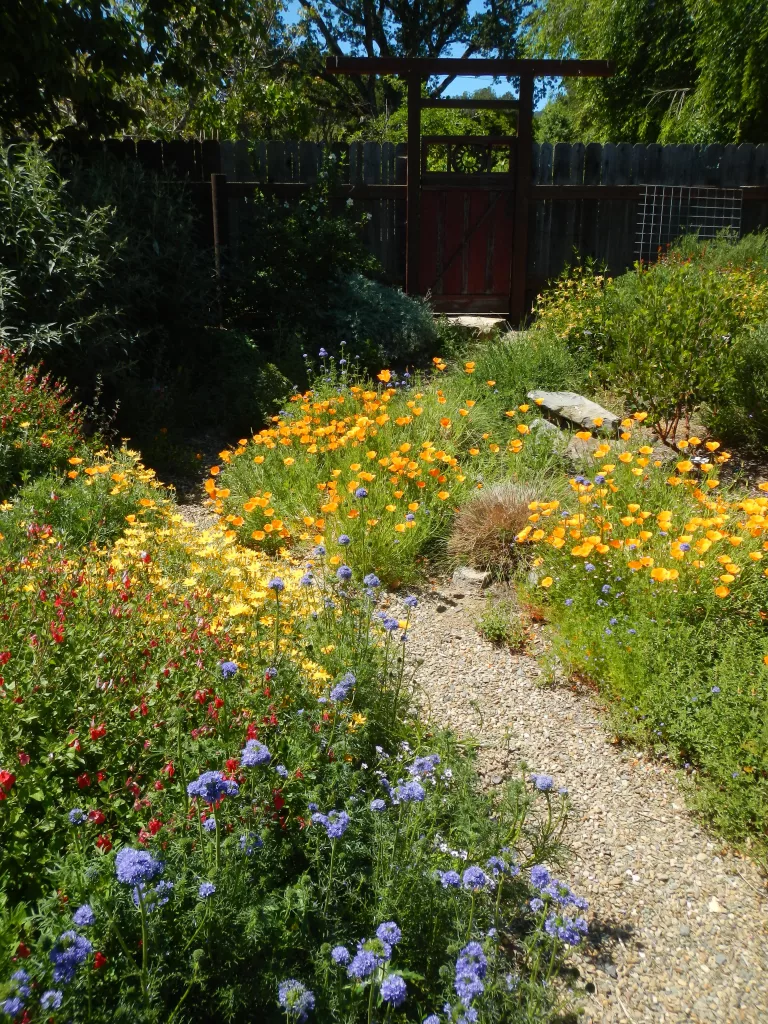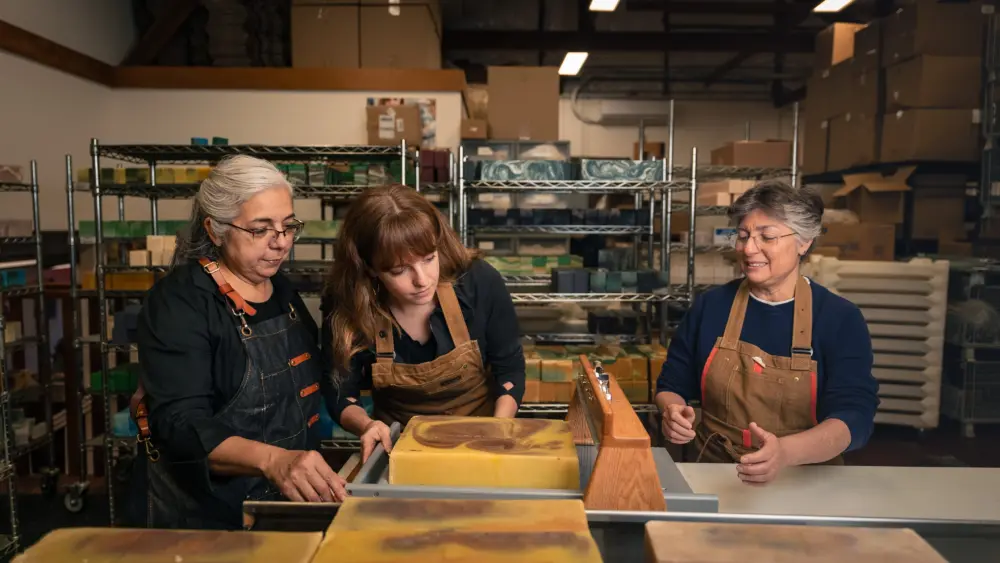
Jackson Family Wines are committed to being stewards of the land through building soil health, conserving water, reducing energy use, preserving wetland and wildlife habitats, and working to increase biodiversity in those habitats. Their gardens include native pollinating plants that support a host of native insects and birds.
From monarch butterflies to songbirds, there is a whole array of native insects and birds that help create a healthy biosphere in the North Bay area. That translates to healthy soil and water which are needed for hearty crops and vineyards.
With crises in biodiversity and crashing numbers of native insects and birds, many in the North Bay have taken up the banner in recreating native habitats—and are creating hope along with every native plant they put in the ground.
Perhaps one of the most well-known of the North Bay native pollinators is the Western Monarch Butterfly. Suzanne Clarke, founder of the Sonoma County Butterfly Alliance (SCBA), has been working with the Marin Monarch Working Group to create a pollinator corridor for the Western Monarchs.
The Western Monarchs spend the winter along the Marin coast and then travel inland toward Sonoma Valley. Alarmingly, their numbers have dropped 99% since the 1980s because of climate change, habitat loss, pesticide use and parasites. The pollinator corridor would help them by providing what they need along the coast as well as on their journey into Sonoma County.
Normally the butterflies would leave the Marin coastal area between March and April, but the warming climate has caused them to leave earlier. Clarke says another impact of climate change is the uncertainty of when the milkweed will emerge. This is problematic because native milkweed is the only plant that provides habitat for the monarch’s eggs.
“When they come out, they need to have not only milkweed to lay eggs on, but pollinating plants with their nectar to feed the adults as they move along,” Clarke says. Butterflies and other insects need the nectar from the pollinating plants and native bees need the pollen. The corridor will therefore support far more than just the monarchs.
“They used to come out of Bodega Bay, but now it’s Bolinas southward and they move inland to Sonoma Valley,” Clarke says. “So that area is critical. With all the agricultural development, the natural milkweed paths have been depleted.”
It’s possible that those same agricultural operations could help to rebuild what has been lost. Across the North Bay area many farms and wineries are utilizing the more sustainable and valuable biodynamic, regenerative farming practices and supporting or even replanting native habitat.
“My hope is that more vineyards, the wineries themselves could dedicate an acre or something to native wildflowers, milkweed and such,” Clarke says, noting that native-habitat planting is being done at Kendall-Jackson winery by a fellow master gardener.
Tucker Taylor is the director of the culinary gardens at Kendall-Jackson Wine Estate in Fulton. The culinary gardens support the in-house culinary team as well as other restaurants in the Bay area. “We’re growing for a total of 30 Michelin stars right now,” Taylor says.

Taylor redesigned the culinary garden 10 years ago and part of that redesign was to surround it with perennial borders. They’ve included native plants in the borders, including giant hyssop, native milkweed, alpine alumroot and long-tube irises.
“In the spring and summer, it’s just a riot of color surrounding the garden,” Taylor says. “In addition to adding beauty to the garden, they’re also instrumental in attracting beneficial insects, and pollinators.”
Over the years they’ve noticed a dramatic decrease in pest pressure and a dramatic increase in biodiversity. They’re seeing more bluebirds, native bees, dragonflies, moths and many species of butterflies. “In my experience, when you plant a highly diversified garden, it sort of comes into a balance,” Taylor says.
Many of the native insects are helping to pollinate some of their crops and fruit trees. Taylor says they also help by preying on insect and rodent pests. “For example, the convergent lady beetle (Hippodamia convergens) will feast on aphids in both the larval stage as well as the adult stage which aids in keeping these pest populations in check,” he says.
They planted the native narrowleaf and showy milkweed several years ago to attract monarch butterflies. “We’ve not only had success in attracting the monarchs, but we’ve also had success in these plants naturalizing,” Taylor says. “They’ve already reseeded in our garden and spread. It’s become so successful that we’ve created a whole other space in hopes of creating more habitat for the monarchs.”
As to whether increasing biodiversity on the estate might be helping the vineyard’s grapes, Taylor spoke about the health of the soil and explained that good biodiversity helps with soil health. That in turn helps the grapes. “We consider ourselves soil farmers, since that’s the foundation of everything we do,” he says.
The Jackson Family Wines have a commitment to being stewards of the land with ecologically good practices on all of their wineries. In 2021 they began a 10-year climate action plan for a sustainable future.
Their “Rooted For Good: Roadmap to 2030” plan includes building soil health, conserving water, reducing energy use, preserving wetland and wildlife habitats—and working to increase biodiversity in those habitats.
Those practices help them to create prestigious wines that reflect the terroir of each vineyard site. They have won multiple awards honoring their vision and leadership in winemaking and climate resilience.
Tucker says that guests are often inspired by the way the winery operates. “We have people visiting from around the world, and a lot of them already practice some of these things at home in their yards,” he says. “But some people visit and they see something that they really get excited about and are able to take home with them and put it in a practice at home.”
Clarke also pointed to the many North Bay schools that are taking part in supporting biodiversity by creating pollinator gardens on their school grounds. These gardens create an opportunity for students to enjoy more nature as they learn about the importance of native plants, insects and birds in their outdoor “classrooms.”
Sonoma Valley High School junior Kendall Clemons is working with Clarke, other community members and the Sonoma Ecology Center (SEC) to create a pollinator habitat garden at the high school. SEC is also working with the Sonoma Botanical Garden in Glen Ellen to design and establish a California native plant demonstration garden around their welcome center.
The ecology center oversees the Sonoma Valley Wildlife Corridor. Wildlife corridors allow mammals to move across their historic paths unimpeded and with native plants and trees along the way to support the entire ecosystem. Pollinator corridors are similar in that they support declining populations of native insects and birds as they move along their historic flight paths and find the native plants that they need along the way.
“The pollinator superhighway would be basically for birds and insects,” Clarke says. “As native insects begin to thrive then, in turn, native birds will begin to thrive.”
Unlike the unimpeded wildlife corridors, a pollinator corridor can be supported by interspersed areas with native plants. This means that locals can support their native insects and birds by including native wildflowers in their gardens, by creating hedgerows with native plants or even creating a separate native pollinator garden.
Clarke is a master gardener and has created habitat for native butterflies as well as other native insects and birds around her home. She encourages others to create native habitat as well as helping with information about how to go about it on her SCBA Facebook page.

“Some people think natives aren’t very pretty, but if you come to my garden, you wouldn’t believe how many people I have stop and look in my garden and say how beautiful it is,” she says.
Clarke is a former president of the Petaluma Garden Club (PGC) and helped create the Butterfly Garden in Petaluma’s Wickersham Park. Clarke and a group of PGC volunteers called Flutterby’s now care for the garden. Clarke is working with the PGC to create more pollinator gardens and the PGC is also educating its members about the importance of creating native habitat.
Clarke is also working with the Petaluma Sunrise Rotary, which provided the milkweed to Sonoma County residents at the PGC plant sale in late April and Petaluma’s Art & Garden Festival in July.
Clarke praised the work of Dr. Doug Tallamy, an entomologist, ecologist and conservationist whose books, lectures and YouTube videos are valuable resources. She mentioned that Tallamy speaks about the importance of hedgerows because they create a place along the field for birds and insects to shelter in and have their offspring.
Nesting songbirds need a whopping 5,000 caterpillars for their offspring. “The thing is, we all love songbirds, and we don’t see them as much anymore,” Clarke says. “They need caterpillars. And so where do they find them? They find them on your backyard garden’s vegetables and on the larger fields of vegetables.”
Veronica Bowers, founder and director of Native Songbird Care & Conservation in Sebastopol agrees with Clarke. “I can tell you that, in general, songbird populations are in decline, some species more dramatically than others,” Bowers says.
“Even our most common species like dark-eyed junco and American robins are in decline,” Bowers says. “And the drivers of those declines all derive from anthropogenic causes like window collisions, free roaming cats and pesticide use. Loss of habitat is, of course, the larger overarching theme.”
Bowers explains that loss of habitat means loss of vital resources, meaning all the plant life that’s required to sustain insect life. Those same insects are necessary to sustain the health of songbird populations.
“You have habitat loss on their wintering grounds and on their breeding grounds,” Bowers says. “And now we’re really starting to see the impact of climate change and how that’s reducing healthy habitats.”
Bowers says many species of migratory songbirds aren’t able to adapt quickly enough to the changing climate. “We have species who are shifting their ranges in response to climate change,” she says. “There’s a lot going on, on planet Earth and in our immediate local area, that’s having significant impact on songbird populations.”

In order to create more habitat at her home in Sebastopol, Bowers looked to the native plants and trees that were growing in a protected parcel near her property. “There is Western hazelnut, black oak and live oak and there’s some willow growing back there,” she says. “There are some native plants and trees, and I noticed that there was a lot of bird diversity back along that creek.”
Continues Bowers: “I really keyed into the species that we had occurring in that area, what their needs were, and then tried to replicate that on our property and kind of build on that already existing habitat corridor. We just extended it by virtue of planting native plants on our property.”
Almost 25 years later, Bowers says they have 33 species of songbirds who nest on the property during the breeding season and over 100 different species of birds that occur throughout the year. “It’s primarily because we have created habitat,” she says.
She says they’ve been hosting a bio blitz with their summer interns and the results have been impressive. “The bird diversity as well as butterflies, dragonflies, bees and all of our wonderful insect life that is here is because of our effort to create habitat,” Bowers says. “We’ve created habitat to sustain biodiversity here and we owe that to the foundation of mostly native plants.”
For those curious about which native plants might be easiest to start with, or the ones that support certain species, Clarke suggests the California Native Plant Society’s website Calscape.
Many local master gardeners, like Clarke, enjoy having Mediterranean plants like lavender growing in their gardens. “You can have a few non-natives like lavender—which just happens to be an amazing, long-flowering pollinating plant,” Clarke says. “But then plant as many native plants as you can in and around those.”
Basically, the structural plants would be native and those would be accented with non-natives so long as they’re useful in pollinating, she says.
“A butterfly can get nectar from any kind of pollinating flowers, so that is absolutely true,” Clarke says. “But there are other kinds of insects that are plant specific. It’s just like the butterfly will only lay eggs on specific plants. That’s a critical thing. Without that plant the butterfly will cease to exist.”
Even apartment dwellers can help support local native insects and birds by having native wildflowers in pots on their balconies and decks. Many cities are beginning to incorporate areas with native plants into their parks and other open spaces. These areas are beneficial for the native insects and birds and locals get to enjoy the more natural settings.
On the eastern side of Marin County lies the more developed city center corridor. Last year was the 50th anniversary of the Marin Countywide Plan and, while looking ahead to the next 50 years, residents were considering how they could improve nature in that area.
With that in mind, MarinBiodiversity, a collaboration of organizations working to support native habitat, have come together and are working on the Marin Biodiversity Corridor Initiative (MBCI) with a big push to create more habitat in that city center corridor.
Dr. Paul da Silva explains that all of the MarinBiodiversity member organizations support one another in efforts to increase native habitat across the county. The Marin Monarch Working Group is one of the member organizations and MarinBiodiversity is supporting their work in the coastal region as well.
Da Silva is a trustee and professor emeritus at the College of Marin and a past president of the Pacific Coast Entomological Society. He is also a board member of the Marin Chapter of the California Native Plant Society, which is collaborating with MarinBiodiversity.

MarinBiodiversity has also been working to educate the public about the biodiversity crisis. Da Silva says that even though the public is starting to understand that there is a climate crisis, one of the biggest challenges is a general lack of awareness that the biodiversity crisis exists.
“I think it’s because a big fire or a big hurricane are going to appear on the television news, they can be in big pictures on the front pages of newspapers and magazines,” da Silva says. “But the biodiversity crisis, when you think about that collective loss of 30% of the birds in North America since the 1970s, what does that look like? It’s hard to visualize that—yet it is extremely serious.”
On Dec. 7, 2022 the World Bank released “Securing Our Future Through Biodiversity,” a report which spoke to the impact of the loss and degradation of biodiversity. In it they stated that more than 50% of the global Gross Domestic Product—$44 trillion in economic value at the time—is dependent upon natural resources. Without biodiversity, ecosystems begin to collapse and, along with them, all of those natural resources.
Da Silva hopes that knowledge about these types of impact will help bring more understanding. “I think that the first goal is to raise people’s awareness so that they say, ‘OK, this really is an important thing,’” he says.
Da Silva also likes making sure people understand why native habitat is so important to biodiversity. “The reason that there are more insects and birds in the native plant habitat is because over millions of years the insects have adapted to specific plants,” he says. “They specialize in those specific plants, and the birds have specialized in specific insects and so on.”
Da Silva says he would like to see more encouragement from homeowner associations, city and town governments. “We have the different service clubs and all of these different ways that we as humans organize ourselves,” da Silva says. “If they become aware that this is important and that we should encourage these types of actions, I think we’ll go a long way.”
[Editor’s note: The lead photo from Kendall-Jackson Wine initially ran with an incorrect caption. The information has been corrected.]



